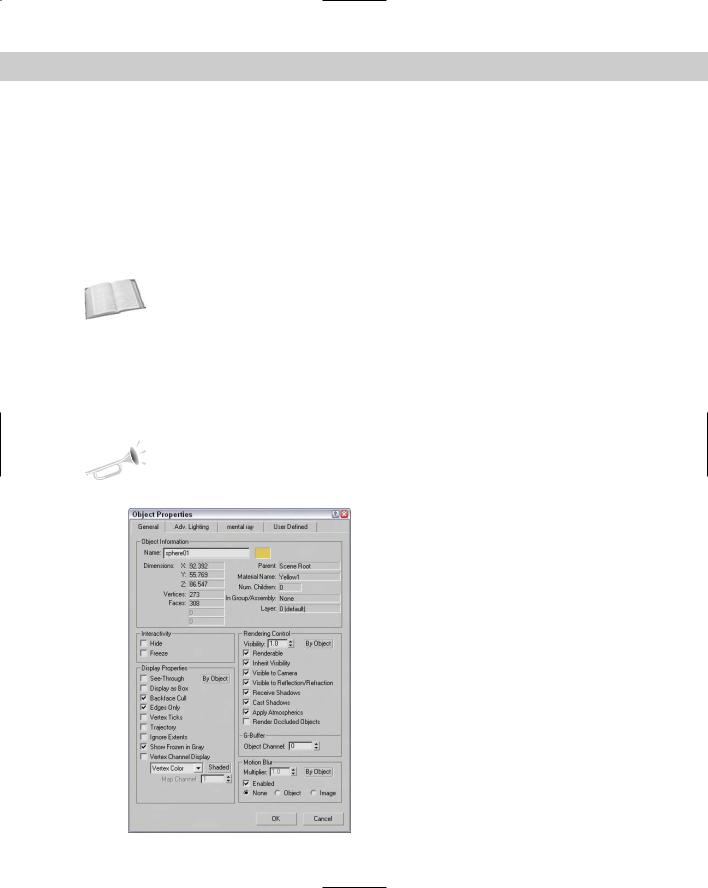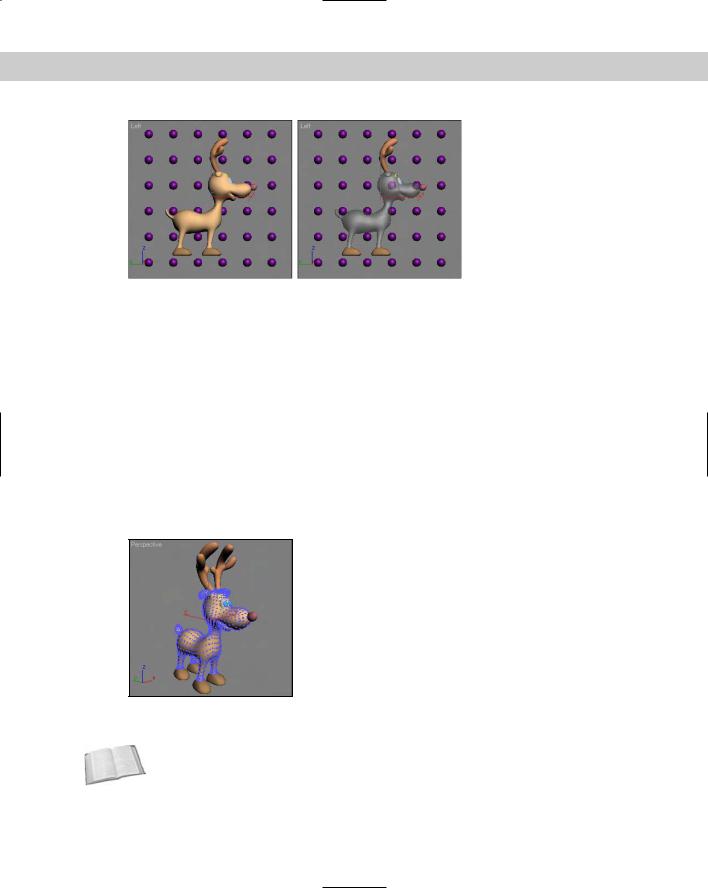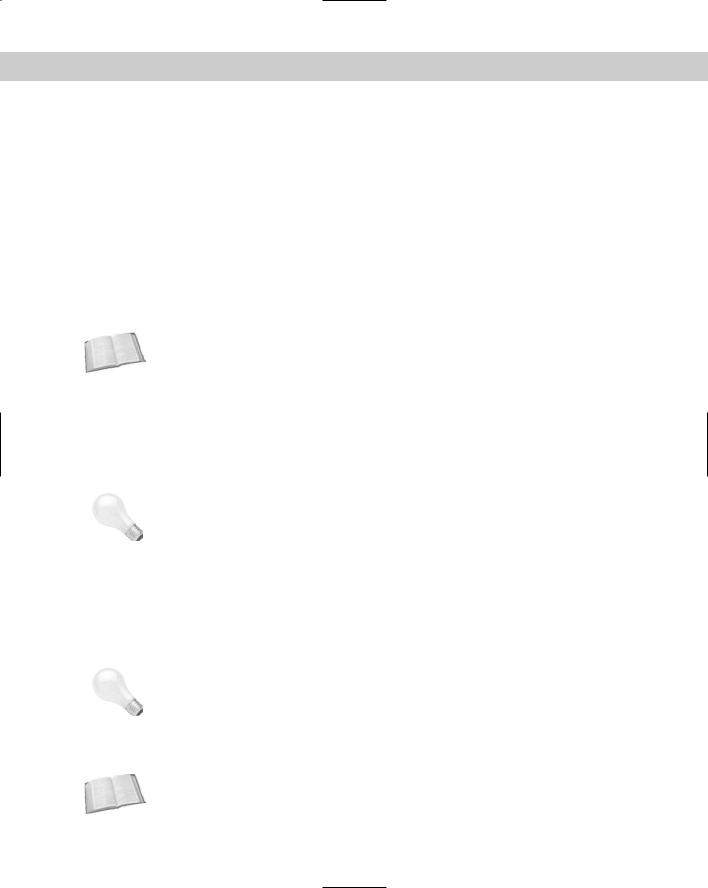
- •Preface
- •About This Book
- •Acknowledgments
- •Contents at a Glance
- •Contents
- •Relaxing at the Beach
- •Dressing the Scene
- •Animating Motion
- •Rendering the Final Animation
- •Summary
- •The Interface Elements
- •Using the Menus
- •Using the Toolbars
- •Using the Viewports
- •Using the Command Panel
- •Using the Lower Interface Bar Controls
- •Interacting with the Interface
- •Getting Help
- •Summary
- •Understanding 3D Space
- •Using the Viewport Navigation Controls
- •Configuring the Viewports
- •Working with Viewport Backgrounds
- •Summary
- •Working with Max Scene Files
- •Setting File Preferences
- •Importing and Exporting
- •Referencing External Objects
- •Using the File Utilities
- •Accessing File Information
- •Summary
- •Customizing Modify and Utility Panel Buttons
- •Working with Custom Interfaces
- •Configuring Paths
- •Selecting System Units
- •Setting Preferences
- •Summary
- •Creating Primitive Objects
- •Exploring the Primitive Object Types
- •Summary
- •Selecting Objects
- •Setting Object Properties
- •Hiding and Freezing Objects
- •Using Layers
- •Summary
- •Cloning Objects
- •Understanding Cloning Options
- •Mirroring Objects
- •Cloning over Time
- •Spacing Cloned Objects
- •Creating Arrays of Objects
- •Summary
- •Working with Groups
- •Building Assemblies
- •Building Links between Objects
- •Displaying Links and Hierarchies
- •Working with Linked Objects
- •Summary
- •Using the Schematic View Window
- •Working with Hierarchies
- •Setting Schematic View Preferences
- •Using List Views
- •Summary
- •Working with the Transformation Tools
- •Using Pivot Points
- •Using the Align Commands
- •Using Grids
- •Using Snap Options
- •Summary
- •Exploring the Modifier Stack
- •Exploring Modifier Types
- •Summary
- •Exploring the Modeling Types
- •Working with Subobjects
- •Modeling Helpers
- •Summary
- •Drawing in 2D
- •Editing Splines
- •Using Spline Modifiers
- •Summary
- •Creating Editable Mesh and Poly Objects
- •Editing Mesh Objects
- •Editing Poly Objects
- •Using Mesh Editing Modifiers
- •Summary
- •Introducing Patch Grids
- •Editing Patches
- •Using Modifiers on Patch Objects
- •Summary
- •Creating NURBS Curves and Surfaces
- •Editing NURBS
- •Working with NURBS
- •Summary
- •Morphing Objects
- •Creating Conform Objects
- •Creating a ShapeMerge Object
- •Creating a Terrain Object
- •Using the Mesher Object
- •Working with BlobMesh Objects
- •Creating a Scatter Object
- •Creating Connect Objects
- •Modeling with Boolean Objects
- •Creating a Loft Object
- •Summary
- •Understanding the Various Particle Systems
- •Creating a Particle System
- •Using the Spray and Snow Particle Systems
- •Using the Super Spray Particle System
- •Using the Blizzard Particle System
- •Using the PArray Particle System
- •Using the PCloud Particle System
- •Using Particle System Maps
- •Controlling Particles with Particle Flow
- •Summary
- •Understanding Material Properties
- •Working with the Material Editor
- •Using the Material/Map Browser
- •Using the Material/Map Navigator
- •Summary
- •Using the Standard Material
- •Using Shading Types
- •Accessing Other Parameters
- •Using External Tools
- •Summary
- •Using Compound Materials
- •Using Raytrace Materials
- •Using the Matte/Shadow Material
- •Using the DirectX 9 Shader
- •Applying Multiple Materials
- •Material Modifiers
- •Summary
- •Understanding Maps
- •Understanding Material Map Types
- •Using the Maps Rollout
- •Using the Map Path Utility
- •Using Map Instances
- •Summary
- •Mapping Modifiers
- •Using the Unwrap UVW modifier
- •Summary
- •Working with Cameras
- •Setting Camera Parameters
- •Summary
- •Using the Camera Tracker Utility
- •Summary
- •Using Multi-Pass Cameras
- •Creating Multi-Pass Camera Effects
- •Summary
- •Understanding the Basics of Lighting
- •Getting to Know the Light Types
- •Creating and Positioning Light Objects
- •Viewing a Scene from a Light
- •Altering Light Parameters
- •Working with Photometric Lights
- •Using the Sunlight and Daylight Systems
- •Using Volume Lights
- •Summary
- •Selecting Advanced Lighting
- •Using Local Advanced Lighting Settings
- •Tutorial: Excluding objects from light tracing
- •Summary
- •Understanding Radiosity
- •Using Local and Global Advanced Lighting Settings
- •Working with Advanced Lighting Materials
- •Using Lighting Analysis
- •Summary
- •Using the Time Controls
- •Working with Keys
- •Using the Track Bar
- •Viewing and Editing Key Values
- •Using the Motion Panel
- •Using Ghosting
- •Animating Objects
- •Working with Previews
- •Wiring Parameters
- •Animation Modifiers
- •Summary
- •Understanding Controller Types
- •Assigning Controllers
- •Setting Default Controllers
- •Examining the Various Controllers
- •Summary
- •Working with Expressions in Spinners
- •Understanding the Expression Controller Interface
- •Understanding Expression Elements
- •Using Expression Controllers
- •Summary
- •Learning the Track View Interface
- •Working with Keys
- •Editing Time
- •Editing Curves
- •Filtering Tracks
- •Working with Controllers
- •Synchronizing to a Sound Track
- •Summary
- •Understanding Your Character
- •Building Bodies
- •Summary
- •Building a Bones System
- •Using the Bone Tools
- •Using the Skin Modifier
- •Summary
- •Creating Characters
- •Working with Characters
- •Using Character Animation Techniques
- •Summary
- •Forward versus Inverse Kinematics
- •Creating an Inverse Kinematics System
- •Using the Various Inverse Kinematics Methods
- •Summary
- •Creating and Binding Space Warps
- •Understanding Space Warp Types
- •Combining Particle Systems with Space Warps
- •Summary
- •Understanding Dynamics
- •Using Dynamic Objects
- •Defining Dynamic Material Properties
- •Using Dynamic Space Warps
- •Using the Dynamics Utility
- •Using the Flex Modifier
- •Summary
- •Using reactor
- •Using reactor Collections
- •Creating reactor Objects
- •Calculating and Previewing a Simulation
- •Constraining Objects
- •reactor Troubleshooting
- •Summary
- •Understanding the Max Renderers
- •Previewing with ActiveShade
- •Render Parameters
- •Rendering Preferences
- •Creating VUE Files
- •Using the Rendered Frame Window
- •Using the RAM Player
- •Reviewing the Render Types
- •Using Command-Line Rendering
- •Creating Panoramic Images
- •Getting Printer Help
- •Creating an Environment
- •Summary
- •Creating Atmospheric Effects
- •Using the Fire Effect
- •Using the Fog Effect
- •Summary
- •Using Render Elements
- •Adding Render Effects
- •Creating Lens Effects
- •Using Other Render Effects
- •Summary
- •Using Raytrace Materials
- •Using a Raytrace Map
- •Enabling mental ray
- •Summary
- •Understanding Network Rendering
- •Network Requirements
- •Setting up a Network Rendering System
- •Starting the Network Rendering System
- •Configuring the Network Manager and Servers
- •Logging Errors
- •Using the Monitor
- •Setting up Batch Rendering
- •Summary
- •Compositing with Photoshop
- •Video Editing with Premiere
- •Video Compositing with After Effects
- •Introducing Combustion
- •Using Other Compositing Solutions
- •Summary
- •Completing Post-Production with the Video Post Interface
- •Working with Sequences
- •Adding and Editing Events
- •Working with Ranges
- •Working with Lens Effects Filters
- •Summary
- •What Is MAXScript?
- •MAXScript Tools
- •Setting MAXScript Preferences
- •Types of Scripts
- •Writing Your Own MAXScripts
- •Learning the Visual MAXScript Editor Interface
- •Laying Out a Rollout
- •Summary
- •Working with Plug-Ins
- •Locating Plug-Ins
- •Summary
- •Low-Res Modeling
- •Using Channels
- •Using Vertex Colors
- •Rendering to a Texture
- •Summary
- •Max and Architecture
- •Using AEC Objects
- •Using Architectural materials
- •Summary
- •Tutorial: Creating Icy Geometry with BlobMesh
- •Tutorial: Using Caustic Photons to Create a Disco Ball
- •Summary
- •mental ray Rendering System
- •Particle Flow
- •reactor 2.0
- •Schematic View
- •BlobMesh
- •Spline and Patch Features
- •Import and Export
- •Shell Modifier
- •Vertex Paint and Channel Info
- •Architectural Primitives and Materials
- •Minor Improvements
- •Choosing an Operating System
- •Hardware Requirements
- •Installing 3ds max 6
- •Authorizing the Software
- •Setting the Display Driver
- •Updating Max
- •Moving Max to Another Computer
- •Using Keyboard Shortcuts
- •Using the Hotkey Map
- •Main Interface Shortcuts
- •Dialog Box Shortcuts
- •Miscellaneous Shortcuts
- •System Requirements
- •Using the CDs with Windows
- •What’s on the CDs
- •Troubleshooting
- •Index

Chapter 6 Selecting Objects and Setting Object Properties |
199 |
A third interface that you can use to select objects is the Schematic View, which is opened using the Graph Editors New Schematic View menu command. It offers a hierarchical look at your scene and displays all links and relationships between objects. Each object in the Schematic View is displayed as a rectangular node.
To select an object in the viewport, find its rectangular representation in the Schematic View and simply double-click it. To select multiple objects in the Schematic View, you need to enable Sync Selection mode with the Select Sync Selection command in the Schematic View menu and then drag an outline over all the rectangular nodes that you want to select.
The Schematic View also includes the Select by Name text field, just like the Curve Editor, for selecting an object by typing its name.
Cross- The Material Editor is covered in detail in Chapter 19, “Exploring the Material Editor,” the Reference Track View is covered in Chapter 33, “Working with the Track View,” and the Schematic View
interface is covered in Chapter 9, “Working with the Schematic View.”
Setting Object Properties
After you select an object or multiple objects, you can view their object properties by choosing Edit Object Properties. Alternatively, you can right-click the object and select Properties from the pop-up menu. Figure 6-8 shows the Object Properties dialog box. This dialog box includes four panels — General, Advanced Lighting, mental ray, and User Defined.
New |
The Object Properties dialog box has changed slightly. Along with rearranging the sections, |
Feature |
the Vertex Channel Display and Map Channel options are new. |
|
Figure 6-8: The Object Properties dialog box displays valuable information about a selected object.

200 Part II Working with Objects
Viewing object information
For a single object, the General panel of the Object Properties dialog box lists details about the object in the Object Information section. These details include the object’s name; color; extent distances from the origin along the X, Y and Z axes; number of vertices and faces; who the object’s parent is; the object’s Material Name; the number of children attached to the object; the object’s group name if it’s part of a group; and the layer on which the object can be found. All this information (except for its name and color) is for display only and cannot be changed.
Note The two fields under the Vertices and Faces are used only when the properties for a Shape are being displayed. These fields show the number of Shape Vertices and Shape Curves.
If the properties for multiple objects are to be displayed, the Object Properties dialog box places the text “Multiple Selected” in the Name field. The properties that are in common between all these objects are displayed. With multiple objects selected, you can set their display and rendering properties all at once.
The Object Properties dialog box can be displayed for all geometric objects and shapes, as well as for lights, cameras, helpers, and Space Warps. Not all properties are available for all objects.
Cross- |
The Hide and Freeze options included in the Interactivity section are covered later in the |
Reference |
chapter in the “Hiding and Freezing Objects” section. |
|
Setting display properties
Display properties don’t affect how an object is rendered, only how it is displayed in the viewports. In this section, along with the Rendering Control and Motion Blur sections, are three By Object/By Layer toggle buttons. If the By Object button is displayed, then options can be set for the selected object, but if the By Layer option is enabled, then all options become disabled and the object gets its display properties from the layer settings found in the Layer Manager.
Note |
You can also find and set the same Display Properties that are listed in the Object Properties |
|
dialog box in the Display Properties rollout of the Display panel in the Command Panel and |
|
in the Display Floater. |
The See-Through option causes shaded objects to appear transparent. This option is similar to the Visibility setting in the Rendering Control section, except that it doesn’t affect the rendered image. It is only for displaying objects in the viewports. This option really doesn’t help in wireframe viewports. Figure 6-9 shows a deer model with spheres behind it with and without this option selected.
Many of these display properties can speed up or slow down the viewport refresh rates. For example, Display as Box increases the viewport update rate dramatically for complex scenes, but at the expense of any detail. This setting can be useful to see how the objects generally fit in comparison to one another. This option can also be accessed from the Viewport Configuration dialog box or from the Viewport name right-click pop-up menu, but the Object Properties dialog box lets you set this option for a single object instead of for the entire viewport.

Chapter 6 Selecting Objects and Setting Object Properties |
201 |
Figure 6-9: The See-Through display property can make objects transparent in the viewports.
The Backface Cull option causes the faces on the backside of the object to not be displayed when turned on. Max considers the direction that each normal is pointing and doesn’t display a face if its normal points away from the view. A normal is a vector that extends perpendicular to the face and is used to determine the orientation of individual faces. This option produces the same result of the Force 2-Sided option in the Viewport Configuration dialog box, except that it can be applied to a single object and not the entire viewport. This display option works only in wireframe viewports.
The Edges Only option displays only the edges of each face when the viewport is set to Wireframe mode. When Edges Only is not selected, a dashed line indicates polygon faces.
When the Vertex subobject mode is selected for an object, all vertices for the selected object appear as blue plus signs. The Vertex Ticks option displays all object vertices in this same way without requiring the Vertex subobject mode. Figure 6-10 shows the deer mesh with this option enabled.
Figure 6-10: The Vertex Ticks option displays all vertices as small blue tick marks.
The Trajectory option displays any animated motions as a spline path.
Cross- |
To learn more about using animated motion paths, see Chapter 30, “Animation Basics.” |
Reference |
|

202 Part II Working with Objects
|
The Ignore Extents option causes an object to be ignored when you are using the Zoom |
|
|
Extents button in the Viewport Navigation controls. For example, if you have a camera or |
|
|
light positioned at a distance from the objects in the scene, then anytime you use the Zoom |
|
|
Extents All button, the center objects are so small that you cannot see them because the |
|
|
Zoom Extents needs to include the distance light. If you set the Ignore Extent option for the |
|
|
camera or light, then the Zoom Extents All button zooms in on just the geometry objects. |
|
|
When objects are frozen, they appear dark gray, but if the Show Frozen in Gray option is |
|
|
disabled, then the object appears as it normally does in the viewport. |
|
|
The Vertex Color option displays the colors of any Editable Mesh vertices that have been |
|
|
assigned colors. You can select to use Vertex Color, Vertex Illumination, Vertex Alpha, Map |
|
|
Channel Color, or Soft Selection Color. The Shaded button causes the meshes to be shaded |
|
|
by the vertex colors. If the Shaded button is disabled, the object is unshaded. You can assign |
|
|
vertex colors only to editable meshes, editable polys, and editable patches. If the Map |
|
|
Channel Color option is selected, you can specify the Map Channel. |
|
Cross- |
|
For more information about vertex colors, check out Chapter 20, “Creating and Applying |
Reference |
Simple Materials.” |
|
|
|
|
|
Setting rendering controls |
|
In the Object Properties dialog box, the Rendering Controls section includes options that |
|
affect how an object is rendered. |
|
The Visibility spinner defines a value for how opaque (non-transparent) an object is. A value |
|
of 1 makes the object completely visible. A setting of 0.1 makes the object almost transparent. |
|
The Inherit Visibility option causes an object to adopt the same visibility setting as its parent. |
Tip |
The Visibility option can also be animated for making objects slowly disappear. |
|
The Renderable option determines whether or not the object is rendered. If this option isn’t |
|
selected, then the rest of the options are disabled because they don’t have any effect if the |
|
object isn’t rendered. The Renderable option is useful if you have a complex object that takes |
|
a while to render. You can disable the renderability of the single object to quickly render the |
|
other objects in the scene. |
|
You can use the Visible to Camera and Visible to Reflection/Refraction options to make |
|
objects invisible to the camera or to any reflections or refractions. This feature can be useful |
|
when you are test-rendering scene elements and raytraced objects. |
Tip |
If an object has the Visible to Camera option disabled and the Cast Shadows option enabled, |
|
then the object isn’t rendered, but its shadows are. |
|
The Receive Shadows and Cast Shadows options control how shadows are rendered for the |
|
selected object. The Apply Atmospherics options enable or disable rendering atmospherics. |
|
Atmospheric effects can increase the rendering time by a factor of 10, in some cases. |
Cross- |
Atmospheric effects are covered in Chapter 42, “Using Atmospheric Effects.” |
Reference |
|

Chapter 6 Selecting Objects and Setting Object Properties |
203 |
The Render Occluded Objects option causes the rendering engine to render all objects that are hidden behind the selected object. The hidden or occluded objects can have glows or other effects applied to them that would show up if rendered.
You use the G-Buffer Object Channel value to apply Render or Video Post effects to an object. By matching the Object Channel value to an effect ID, you can make an object receive an effect.
Cross- |
Render effects are covered in Chapter 43, “Using Render Elements and Effects,” and the |
Reference |
Video Post interface is covered in Chapter 47, “Using the Video Post Interface.” |
|
Enabling Motion Blur
You can also set Motion Blur from within the Object Properties dialog box. The Motion Blur effect causes objects that move fast (such as the Road Runner) to be blurred (which is useful in portraying speed). The render engine accomplishes this effect by rendering multiple copies of the object or image.
Cross- |
More information on these blur options is in Chapter 41, “Rendering Basics.” |
Reference |
|
The Object Properties dialog box can set two different types of Motion Blur: Object and Image. Object motion blur affects only the object and is not affected by the camera movement. Image motion blur applies the effect to the entire image and is applied after rendering.
Cross- A third type of Motion Blur is called Scene Motion Blur and is available in the Video Post Reference interface. See Chapter 47, “Using the Video Post Interface,” for information on using Scene
Motion Blur.
You can turn the Enabled option on and off as an animation progresses, allowing you to motion blur select sections of your animation sequence. The Multiplier value is enabled only for the Image Motion Blur type. It is used to set the length of the blur effect. The higher the Multiplier value, the longer the blurring streaks. The Motion Blur settings found in the Object Properties dialog box can be overridden by the settings in the Render Scene dialog box.
Caution |
If the Motion Blur option in the Object Properties dialog box is enabled but the Motion Blur |
|
option in the Renderer panel of the Render Scene dialog box is disabled, then motion |
|
blur will not be included in the final rendered image. |
Using the Advanced Lighting and mental ray panels
The second and third panels in the Object Properties dialog box contain object settings for working with Advanced Lighting and the mental ray renderer. Using the settings in the Advanced Lighting panel, you can exclude an object from any Advanced Lighting calculations, set an object to cast shadows and receive illumination, and set the number of refine iterations to complete.
The mental ray panel includes options for making an object generate and/or receive caustics and global illumination.
